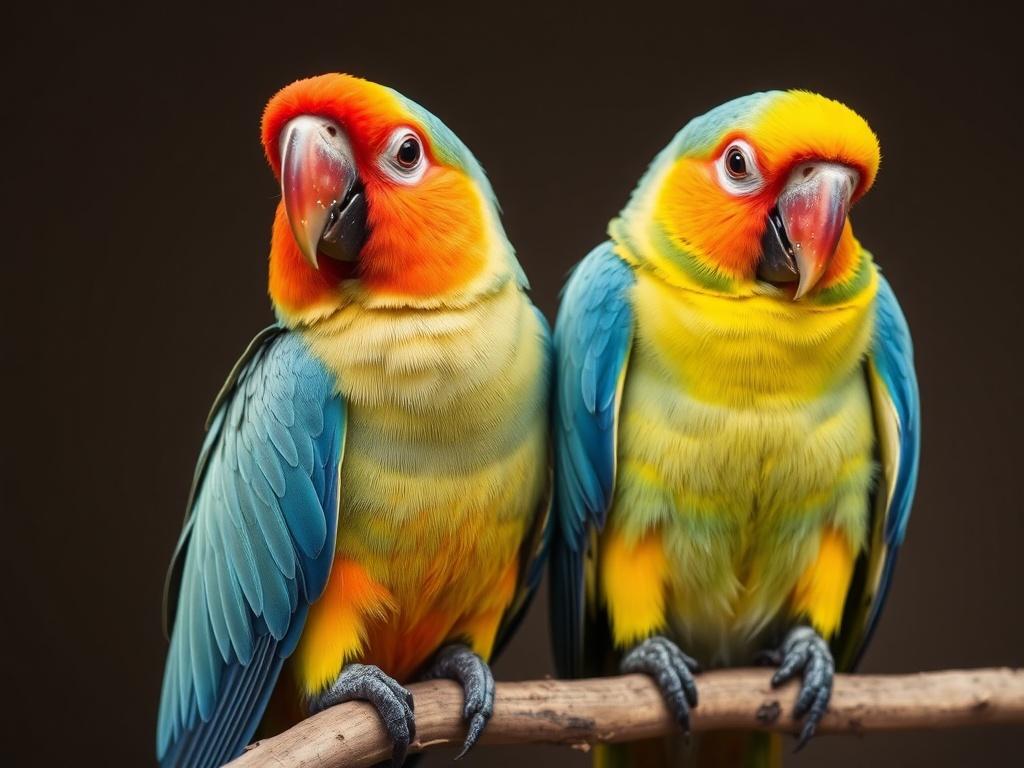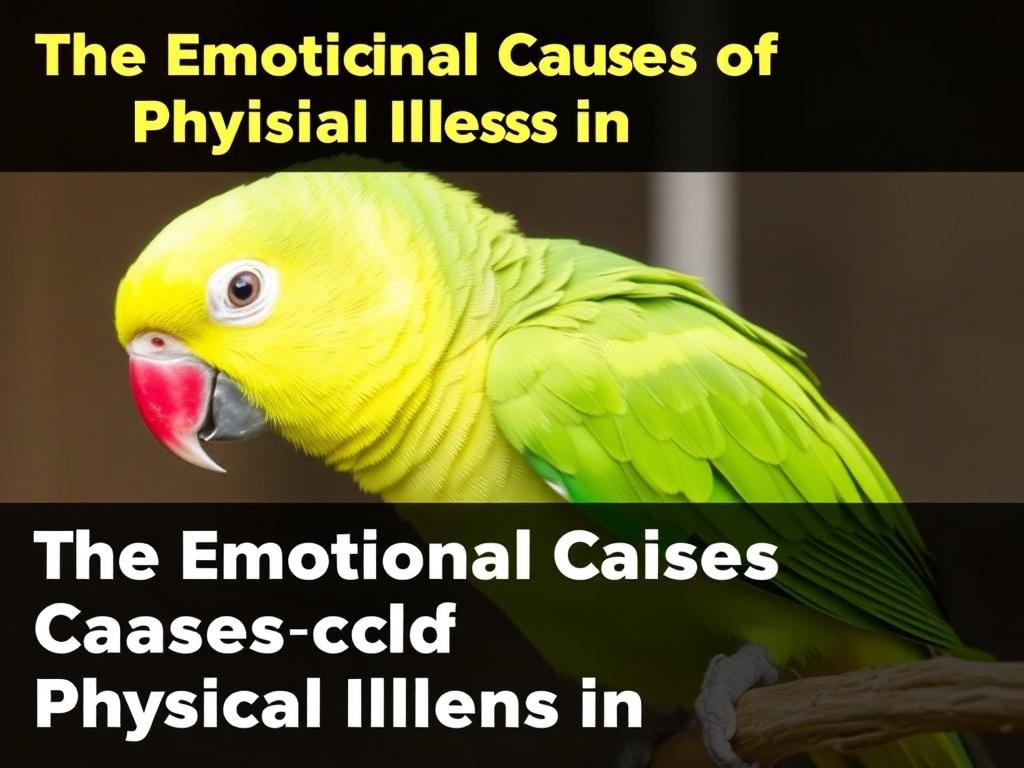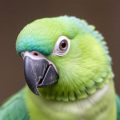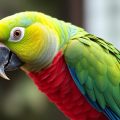Содержание
- Why Emotions Matter: The Biology Behind Feelings and Illness
- Common Emotional Causes of Physical Illness in Parrots
- Physical Conditions Commonly Linked to Emotional Causes
- How to Recognize Emotional Causes Versus Medical Causes
- Practical Steps: Diagnosing and Treating Emotion-Linked Illness
- Prevention: Building Resilience Before Problems Start
- Tools and Resources: Practical Lists and a Table
- Troubleshooting Tough Cases
- Real-Life Vignettes: Lessons from Parrot Owners
- Final Practical Tips for Every Parrot Owner
- Conclusion
SQLITE NOT INSTALLED
Parrots are more than colorful feathers and clever tricks. They are intense social creatures with complex emotional lives. When their emotional needs are neglected, misunderstood, or repeatedly strained, the consequences can ripple into physical illness. This article explores the fascinating — and sometimes heartbreaking — ways emotions can cause or worsen physical disease in parrots. We’ll talk about what happens inside their bodies when they’re stressed, lonely, fearful, or depressed, how to spot the signs early, and practical steps owners and caretakers can take to support both mind and body. Whether you’re a new parrot guardian or a seasoned avian enthusiast, this guide will help you see your bird as a sensitive, feeling being whose health depends as much on emotional wellbeing as on diet or veterinary care.
Emotional distress in parrots is not a single event; it’s a process. Short-term stress — a vet visit, a thunderstorm, unfamiliar visitors — can be handled by a healthy bird with a quick return to normal. But when negative emotional states become chronic — ongoing anxiety, chronic loneliness, relentless boredom, or persistent fear — the bird’s nervous, endocrine, and immune systems are altered in ways that invite illness. Understanding this connection is the first step toward prevention and recovery.
Why Emotions Matter: The Biology Behind Feelings and Illness

Most of us know emotions as internal experiences, but in parrots they trigger concrete physiological responses. When a parrot feels threatened, excited, or anxious, its body activates the hypothalamic-pituitary-adrenal (HPA) axis, producing stress hormones such as corticosterone (the avian equivalent of cortisol in mammals). These hormones prepare the bird to respond to immediate danger — increasing heart rate, redirecting energy from digestion and immune function to muscles, and sharpening sensory perception. That acute response is adaptive and helpful for short-term threats.
The trouble starts when stressors are continuous. Chronic activation of the HPA axis suppresses immune function, alters metabolism, impairs reproductive systems, and can even change brain chemistry. Over time, this makes parrots more susceptible to infections, gastrointestinal problems, feather and skin disorders, and behavioral illnesses like feather plucking. The physiology is simple: persistent emotional strain becomes chronic hormonal imbalance, which weakens the body and creates conditions where physical disease can develop or worsen.
At the same time, emotional states influence behavior in ways that affect health. A lonely or depressed parrot may eat less, abandon foraging behavior, sleep poorly, and show reduced movement — all of which can lead to weight loss, malnutrition, obesity (paradoxically, in birds that overeat comfort food), muscle wasting, or fatty liver disease. Fear or chronic agitation can lead to repetitive, self-destructive behaviors like feather plucking or skin biting. So emotions exert direct hormonal effects and indirect behavioral effects that together shape physical health.
Stress Hormones, Immunity, and Disease
Corticosterone, released during stress, downregulates aspects of the immune response. It’s useful during brief emergencies because it reduces inflammation that might otherwise damage tissues during active escape or fight. But prolonged corticosterone exposure interferes with white blood cell function, reduces antibody production, and makes the bird less able to control infections. Chronic stress is linked to increased incidence and severity of respiratory infections, fungal infections like aspergillosis, and slower recovery from wounds.
Beyond the immune system, chronic stress alters the digestive tract. Stress affects gut motility and the balance of gut microbes (the microbiome), which can cause diarrhea, reduced nutrient absorption, and increased vulnerability to gastrointestinal pathogens. The metabolic shifts due to stress hormones — moving energy toward immediate survival and away from long-term maintenance — can predispose to metabolic and reproductive disorders.
Common Emotional Causes of Physical Illness in Parrots
Understanding specific emotional triggers helps owners identify and remove those stressors. Below are common emotional causes, explained simply:
Loneliness and Social Deprivation
Parrots are highly social; in the wild they live in flocks and maintain complex social bonds. In captivity, many parrots live alone in a home where the human caregiver is their only companion. Without adequate social interaction, a parrot can become depressed, anxious, or overly intense in seeking attention, which can manifest physically as poor appetite, feather plucking, weight loss or gain, and weakened immune responses.
Boredom and Lack of Mental Stimulation
Boredom is not just “being bored” — it’s a state of chronic under-stimulation. Parrots are intelligent and need daily mental challenges. Boredom can drive them to destructive behaviors (gnawing, feather damage), reduce appetite for nutritious foods in favor of repetitive snacking, and trigger stress hormone release. Over time, lack of enrichment can lead to obesity (from sedentary life), muscle atrophy, and chronic behavioral disorders.
Fear and Chronic Anxiety
Individual fear triggers vary: loud noises, sudden movements, unfamiliar people or animals, or previous trauma can create a persistent baseline of anxiety. Chronically anxious birds are at higher risk for stress-linked illness: poor immune response, digestive problems, and cardiovascular strain. Anxiety can also fuel unsafe behaviors (panicked flying or self-harm) that cause injury or secondary infection.
Grief and Loss
Parrots form strong pair bonds, sometimes with other birds and often with human caregivers. The loss of a bonded companion can be devastating. Grief in birds can lead to long-term lethargy, anorexia, weakened immunity, and increased susceptibility to opportunistic infections. Many grieving birds need gradual support to re-establish routines and social enrichment.
Inconsistent Handling and Unpredictable Routines
Parrots thrive on predictable daily rhythms. Inconsistent schedules, erratic caregiver behavior, or sudden environmental changes can cause ongoing low-grade stress. This manifests in poor sleep, increased stress hormone levels, and cumulative wear on bodily systems.
Trauma and Abuse
Physical or emotional abuse — intentional or accidental — creates deep stress that can induce lasting physiological changes. Traumatized parrots may develop ritualized fear behaviors, chronic stress responses, and stress-prone immune profiles. Recovery is possible, but it requires careful rehabilitation and much patience.
Hormonal and Seasonal Factors
Some emotional states are tied to natural breeding cycles. Increased hormone levels during breeding season can cause mood swings, territorial aggression, and frantic behaviors that lead to over-grooming or egg-laying problems (e.g., egg binding). Stress during these cycles can amplify the physical risks.
Physical Conditions Commonly Linked to Emotional Causes
Let’s map emotional states to specific physical illnesses commonly seen in parrots.
Feather Plucking and Self-Mutilation
Feather plucking is perhaps the most visible sign of emotional distress. While medical issues (skin parasites, allergies, infections) can cause plucking, a large portion of chronic feather destruction has behavioral roots: boredom, stress, attention-seeking, or obsessive-compulsive responses to chronic anxiety. Plucking leads to skin damage, infections, and impaired thermoregulation.
Respiratory and Fungal Infections
Chronic stress weakens immune defenses, increasing vulnerability to respiratory pathogens and fungi such as aspergillus. Stress also changes breathing patterns (panting, hyperventilation during anxiety episodes), which can exacerbate respiratory issues. A stressed bird may also spend more time in nest boxes or in corners where mold or poor ventilation increases infection risks.
Gastrointestinal Problems
Stress-induced changes in gut motility and microbiome balance lead to diarrhea, malabsorption, and nutrient deficiencies. Picky eating or anorexia from depression reduces nutrient intake, further compromising immune function and organ health.
Metabolic and Nutritional Disorders
Emotion-driven overeating of unhealthy treats or sedentariness contributes to obesity, fatty liver disease (hepatic lipidosis), and muscle wasting from lack of exercise. Conversely, stress-induced anorexia causes rapid weight loss, muscle wasting, and potentially organ failure if not corrected.
Reproductive and Hormonal Disorders
Chronic emotional stress can disrupt hormonal cycles, leading to abnormal egg production, egg binding, or cessation of normal reproductive behaviors. Hormonal dysregulation also affects mood and behavior, creating a vicious cycle.
Cardiovascular Strain
Chronic agitation and elevated stress hormones increase heart rate and blood pressure over time, placing added strain on the cardiovascular system. While cardiac disease in parrots has multiple causes, chronic stress is a contributing factor.
How to Recognize Emotional Causes Versus Medical Causes
Distinguishing emotional causes from purely medical ones can be tricky because they often overlap. A systematic approach helps:
– Observe for context and triggers. Does the problem flare around specific events (new pets, visitors, moved cage)? Emotional causes often follow identifiable environmental changes.
– Look for behavior patterns. Feather plucking that occurs when the bird is alone or when the caregiver leaves strongly suggests social or attention-related causes.
– Rule out medical issues. Any sudden change in behavior, appetite, or feather condition should prompt a veterinary check to exclude infections, parasites, malnutrition, or organ disease.
– Monitor duration. Acute medical illnesses typically follow a different timeline than chronic stress behaviors that wax and wane over months.
Working together with an avian veterinarian and an experienced behaviorist gives the best chance of correctly identifying underlying causes. Bloodwork, cultures, skin testing, and imaging can exclude or identify medical problems, while careful history and behavior assessment pinpoint emotional contributors.
Case Example: The Lonely African Grey
Consider an African grey named Lila who lives alone while her owner works long hours. Lila begins to pluck her breast feathers and loses weight. A vet rules out mites and skin infections, and blood tests are normal. A behaviorist discovers that Lila’s plucking flares when the owner leaves and is worse on weekends when over-excited. With gradual social enrichment, foraging toys, and a predictable routine, Lila’s plucking lessens and she regains weight. This example shows how social deprivation and boredom, when left unchecked, can produce physical harm.
Practical Steps: Diagnosing and Treating Emotion-Linked Illness
A combined medical and behavioral approach works best. The following is a practical, step-by-step plan:
Step 1 — Immediate Veterinary Assessment
Any bird showing signs of illness (labored breathing, persistent diarrhea, severe feather damage, rapid weight loss, lethargy) needs prompt veterinary care. The vet will perform physical exams, blood tests, fecal tests, and possibly imaging. This rules out treatable medical causes and establishes a baseline.
Step 2 — Detailed Behavioral History
Keep a behavior diary for at least two weeks: note daily routines, social interactions, diet, sleep, environmental changes, and situations that seem to trigger behaviors. This history guides behavior interventions.
Step 3 — Environmental and Social Changes
– Create a predictable daily schedule for feeding, social time, and sleep.
– Establish at least 10–12 hours of quiet, dark sleep per night to restore HPA balance.
– Provide a variety of foraging toys and rotate them regularly to prevent boredom.
– Increase safe social contact: training sessions, supervised out-of-cage time, or introducing a companion bird only with careful professional guidance.
– Optimize cage placement: avoid high-traffic, noisy or drafty areas. Provide choices for privacy.
Step 4 — Enrichment and Training
Training builds mental stimulation and trust. Short, daily training sessions using positive reinforcement can reduce anxiety and redirect obsessive behaviors. Foraging challenges and puzzle feeders engage natural behaviors and reduce idle stress.
Step 5 — Nutritional Support
Work with the vet on a balanced diet. Address deficiencies and metabolic concerns. For birds who overeat, manage treat availability and encourage exercise through flight or climbing opportunities.
Step 6 — Medical and Pharmacologic Support (When Needed)
In some cases, vets may prescribe short courses of anti-anxiety medications or SSRIs under careful supervision. Antibiotics, antifungals, or topical treatments may be required for secondary infections. Never medicate a bird without specialized veterinary guidance.
Step 7 — Behavioral Therapy and Long-Term Monitoring
A certified behaviorist or experienced avian trainer can design long-term plans for severe cases. Progress can be slow; owners should expect incremental improvements rather than overnight cures. Regular veterinary checkups help track physical recovery.
Prevention: Building Resilience Before Problems Start
Prevention is the most powerful tool. Here are actionable strategies to build emotional resilience and reduce the risk of illness:
Social Planning
Plan for sufficient social interaction. If you work long hours, think about playgroups, a second bird companion (with proper introduction), or arranging for in-home sitters. Quality over quantity matters — focused, positive interaction wins.
Environment and Routine
Design a predictable, comfortable environment. Keep the cage in an area where the bird can see household life but also retreat when needed. Maintain a stable daily schedule for feeding, play, and sleep.
Enrichment and Challenges
Invest in a rotating set of toys, foraging opportunities, and physical challenges that encourage flight, climbing, and manipulation. Even simple daily training sessions are immensely beneficial.
Early Socialization and Training
Young birds benefit from positive socialization and training that build confidence and trust. This reduces lifelong anxiety about handling or new situations.
Education and Community
Join local or online avian communities to share strategies and learn signs of emotional distress. Knowledgeable peers and professionals are valuable resources.
Tools and Resources: Practical Lists and a Table
Below are easy-to-use resources to help owners take action.
Red Flags — When to See a Vet Immediately
- Labored breathing, open-mouth breathing, or persistent sneezing
- Sudden or severe weight loss
- Large patches of bleeding or raw skin from plucking
- Severe lethargy, collapse, or inability to perch
- Repeated vomiting, persistent diarrhea, or blood in droppings
- Seizures, head tremors, or disorientation
Enrichment Checklist for Daily Care
- 10–20 minutes of focused social interaction or training at least once daily
- 2–3 foraging opportunities rotated throughout the week
- At least 3–4 different toy types in rotation (chewable, puzzle, shreddable, climbing)
- Safe out-of-cage time for exercise or flight when possible
- Consistent sleep period (10–12 hours) in a quiet, dark room
- Fresh food and water daily; high-quality diet emphasizing variety and nutrition
Sample Plan: 30-Day Reset for a Stressed Bird
- Week 1: Veterinary checkup, begin behavior diary, establish sleep routine, remove obvious stressors
- Week 2: Introduce daily 10-minute training sessions, rotate toys, add foraging opportunities
- Week 3: Increase out-of-cage supervised exercise, evaluate diet with vet, consider socialization options
- Week 4: Evaluate progress, consult behaviorist if no improvement, continue enrichment and routine
Table — Emotional Causes, Typical Physical Signs, and Recommended Interventions
| Emotional Cause | Typical Physical Signs | Likely Physiological Mechanism | Recommended Interventions |
|---|---|---|---|
| Loneliness / social deprivation | Feather plucking, weight loss or gain, reduced grooming | Chronic corticosterone elevation; immune suppression; altered appetite | Increase social contact; foraging toys; predictable routine; consult behaviorist |
| Boredom | Destructive chewing; repetitive behaviors; obesity from inactivity | Lack of mental stimulation -> stress hormone fluctuations; metabolic shifts | Rotate enrichment; training sessions; increase exercise opportunities |
| Fear / chronic anxiety | Panting, feather flaring, digestive upset, avoidance | HPA axis activation; cardiovascular strain; GI motility changes | Desensitization training; safe hiding places; consistent handling; vet if severe |
| Grief / loss | Depression-like withdrawal; anorexia; susceptibility to infection | Stress-induced immune suppression; reduced nutrient intake | Gradual social enrichment; maintain routines; veterinary monitoring |
| Hormonal/seasonal agitation | Excessive vocalization; egg-laying; aggression; over-preening | Elevated reproductive hormones; mood instability | Modify lighting and nesting stimuli; veterinary advice for hormonal management |
Troubleshooting Tough Cases
Some birds have entrenched behavioral illnesses that resist quick fixes. Here’s how to approach these complex situations thoughtfully.
When Progress Is Slow or Nonexistent
If a bird shows little improvement after weeks of intervention, it’s time for a deep dive. Re-evaluate diet and medical workup for subtle illnesses. Consider an extended behavior plan with a certified professional. Patience is key: severe psychological damage sometimes requires months to reverse, and progress is often measured in small steps.
Introducing Another Bird — Pros and Cons
Some owners think adding a second bird is a cure-all for loneliness. But introductions can be risky. A new bird may bring disease, or the resident bird may see the newcomer as a threat, increasing stress. Introductions must be gradual, supervised, and ideally guided by a professional.
When Medications Are Appropriate
Psychotropic medications are sometimes helpful, especially for severe anxiety or obsessive-compulsive behaviors. However, they carry risks and must be prescribed and monitored by an avian veterinarian. Medication should be just one part of a comprehensive plan including environmental and behavioral changes.
Working with a Veterinarian and Behaviorist
A team approach yields the best outcomes. The vet manages medical problems, while a behaviorist creates a long-term enrichment and training plan. Communication among caregivers, vets, and behaviorists prevents duplicated efforts and ensures consistent strategies.
Real-Life Vignettes: Lessons from Parrot Owners
Stories illustrate concepts in a way data often cannot. Here are brief vignettes based on common real-world scenarios.
Vignette 1: Jasper, the Amazon Who Screamed
Jasper’s owner loved him but worked irregular hours. Jasper developed intense screaming and lunging every time a car pulled into the driveway. After a vet check, behavior changes included a predictable morning routine and short training sessions before work, plus a radio on low volume during absences. Jasper’s screaming gradually decreased and his overall health improved.
Vignette 2: Mimi, the Sun Conure with Recurrent Respiratory Infections
Mimi had frequent respiratory infections after being moved to a lower-lit basement during winter. Stress from poor lighting and reduced social contact compounded her susceptibility. Correcting light exposure, improving ventilation, and restoring social time reduced her infections and made her more active.
Vignette 3: Bruno, the Cockatoo with Feather Plucking
Bruno plucked obsessively after his human companion started working from home and unknowingly reinforced attention-seeking. A behaviorist taught the owner to ignore plucking attention bids and reward calm behaviors. Enrichment and structured interaction replaced the negative feedback loop. Bruno’s skin healed slowly and feathers regrew.
Final Practical Tips for Every Parrot Owner
– Observe daily and keep a behavior diary. Patterns become visible only with records.
– Prioritize sleep. A well-rested bird handles stress better.
– Balance social contact with opportunities for independence. Over-dependence can create anxiety when the caregiver is absent.
– Rotate enrichment — novelty reduces boredom.
– Choose a vet experienced with birds and respect their guidance about medications and medical treatment.
– Seek help early. Behavioral issues are easier to address before they cause severe physiological harm.
Conclusion

Emotions are not just abstract states for parrots — they are powerful biological forces that shape health and disease. Chronic loneliness, boredom, fear, grief, inconsistent routines, and hormonal imbalances can all lead to tangible physical illness through stress hormone effects, immune suppression, behavioral changes, and poor nutrition. The good news is that many of these problems are preventable or treatable with attentive care: regular veterinary checks, predictable routines, social enrichment, foraging challenges, positive training, and, when necessary, professional behavioral and medical interventions. Seeing your parrot as a sentient, social being whose emotional life matters is the most important step toward keeping them healthy, vibrant, and loved.





